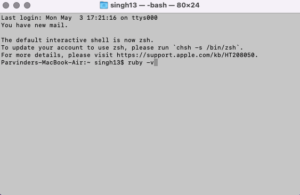

#Macports reinstall ruby install#
Try postgres or sqlite3 for some database variety ( port install postgresql82-server & port install rb-postgres or port install rb-sqlite3, respectively). Reinstall your ports ¶ Save the list of installed ports: port -qv installed > myports.txt Save the list of requested ports: port echo requested cut -d -f 1 uniq > requested.

The ones below, while not required, are often useful when developing rails apps. MacPorts version 2.8. The above ports and gems are the minimum you’ll need to get rails running successfully. Installing Rails Prerequisites with MacPorts $ sudo port install mysql5 +serverįirst, add /opt/local/lib/mysql5/bin/ to your PATH as you did in the instructions to install MacPorts. The /opt paths must be before your standard path so when you type ruby, you use the ruby interpreter from MacPorts rather than the old one that came with OS X. Especially the bit about setting your PATH appropriately. Installing MacPortsįirst thing’s first: Install MacPorts! Be sure to follow the directions closely. sudo port install ruby rb-termios rb-rmagick. MacPorts 1.9.0 added the sqlite portdbformat and MacPorts 2.0.0 dropped the old flat format.The sqlite port DB format is the default for new installations old installations that were upgraded to 1.9.x will continue to use the flat format 1.You can convert a 1.9.x flat system to the sqlite format by upgrading to MacPorts 2. You need the latest version of Xcode tools to be able to compile all the packages necessary for Ruby and Rails. Installation von Ruby on Rails mit MacPorts top Zur vorigen berschrift. This post is an effort to document and standardize all the details to get a Rails stack going with MacPorts. I’ve done this maybe 3 or 4 times in the past year with minor variations each time which inevitably come back to bite me later. I have a clean install of OS X on which I need to install Rails.


 0 kommentar(er)
0 kommentar(er)
